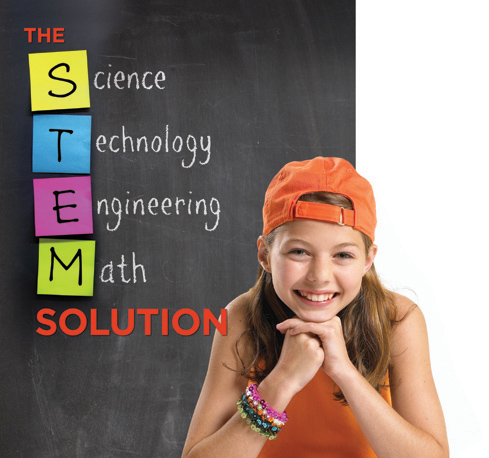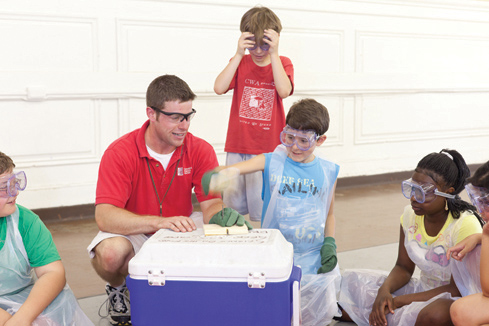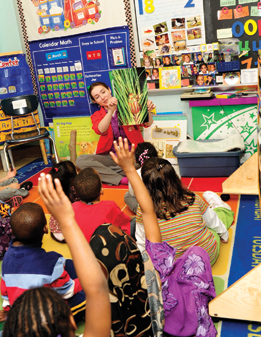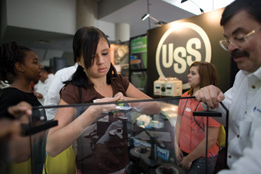 |
|||||
|
Above: Tour Your Future helps girls discover science and technology in the unlikeliest of places, like the world of fashion.
Photo: Renee Rosensteel
|
The STEM Solution
Already a proven leader in informal science education, Carnegie Science Center is now leading the regional charge in critical STEM education with a new center designed to unite community resources. Rather then spend a hot June afternoon cooling off in the pool, 9-year-old Matthew Wellman heads to Carnegie Library of Homestead. Seated with more than a dozen of his peers, he dons an apron and safety goggles as their instructor pulls a banana from a cooler. It’s not your average piece of mushy yellow fruit. Dipped in liquid nitrogen, this banana is hard as a hammer. Literally. So when Wellman, a fourth grader at nearby Park Elementary School in Munhall, grabs the banana with a gloved hand, he can use it to drive a nail through a board. “Cool!” he shouts, as the other students cheer in surprise. This past summer, libraries throughout Pittsburgh were transformed into chemistry labs by the free, weeklong Science in the Summer program run by Carnegie Science Center and sponsored by GlaxoSmithKline Consumer Healthcare. Its aim: to get children excited about science through hands-on experiments with kid appeal, like making slime and growing crystals. “Just look at their interest—this is awesome,” exclaims Liesel Lengyel, pointing to Wellman, her nephew, and his 7-year-old brother, Tyler, as the boys drop chunks of dry ice into a bubbling flask. “They just don’t do things like this in school.” While it may seem like fun and games, programs like Science in the Summer aren’t mere child’s play. Experts say that nothing less than the very fate of our country hinges on our ability to prepare the next generation of innovators in science, technology, engineering, and mathematics—known collectively as STEM—and that learning opportunities outside the classroom play a critical role. Carnegie Science Center has long been the region’s leader in informal science education, serving nearly 480,000 onsite visitors annually and an additional 170,000 children in a five-state region through its Science on the Road program. The Science Center offers a slew of award-winning STEM programs, including the national Future City Competition—which challenges student teams to use SimCity™ software to create a “city of the future” and submit an essay on a related engineering topic—and National Engineers and Chemistry Weeks. Over four days each November and March, nearly 6,000 middle and high school students attend the Science Center’s marquee SciTech Days, where, under the guidance of working scientists and industry leaders, students and their teachers participate in hands-on workshops designed to capture interest in the everyday applications of STEM subjects. And each Spring, more than 1,000 students from some 130 area school districts flock to the North Shore for the Pittsburgh Regional Science and Engineering Fair.
Now the Science Center is building on this proven record of success to deliver even wider-reaching STEM programming. Its planned fall launch of an innovative Center for STEM Education and Career Development will bring together its STEM programming under a single umbrella to share best practices and expand its inventive offerings, says Science Center Co-Director Ann Metzger. Hitting the sweet spotMetzger and Ron Baillie, who share the Henry Buhl, Jr., Director title at the Science Center, along with their seasoned education staff began developing the concept for the Center for STEM Education and Career Development last year, with the aid of a professional advisory board originally convened for SciTech Days. Over the past nine months, they homed in on what will be the center’s four main goals: to make connections among STEM stakeholders, train STEM teachers, inspire students, and raise public awareness. Already in the works: a new and more in-depth training program for science educators in conjunction with community partners. The new center, Metzger explains, will leverage such partnerships with schools, universities, industry and government leaders, and others working on the STEM education front to establish a true forum for collaboration. For instance, a middle school teacher might understand why girls tend to lose interest in science as pre-teens, but a human resource professional seeking to hire female engineers could be baffled by the small candidate pool. Yet these folks don’t necessarily talk to each other to work jointly toward a solution for the gender gap in STEM careers.
Kids discover the power—and coolness factor—of science through informal science education.Photo: Renee Rosensteel“A lot of people are working on different pieces of the STEM education puzzle, but there is no one neutral party in our region who brings everyone together in a ‘town square’ to collectively address these issues,” Metzger says. “That’s the sweet spot that Carnegie Science Center can hit.” Judy Hallinen, assistant vice provost for educational outreach at Carnegie Mellon University, says the Science Center has the goodwill and credibility to be this nexus. “How do you get K-12 schools, higher education, and the business community all involved in a non-competitive way that supports the needs of the region? As a trusted nonprofit with no vested interest in any one group, Carnegie Science Center can do that.”
- Judy Hallinen, Assistant Vice Provost for Educational Outreach at Carnegie Mellon University“It’s a tricky situation,” says Hallinen, a STEM center advisory board member. “How do you get K-12 schools, higher education, and the business community all involved in a non-competitive way that supports the needs of the region? As a trusted nonprofit with no vested interest in any one group, Carnegie Science Center can do that.” Undereducated and underqualifiedWhile final plans for the STEM center are still taking shape, the response from the community has already been tremendous, says Linda Ortenzo, director of STEM programs at Carnegie Science Center. “Everyone we’ve approached is very interested in seeing the Science Center take this leadership role and engage all the different parties,” Ortenzo says. “They recognize what the problem is and know we can really have an impact.” Statistics show the imperative for the new Center for STEM Education and Workforce Development has never been greater. According to the U.S. Bureau of Labor Statistics, eight of the 10 fastest-growing occupations in America are science-, math-, or technology-related. As of last year, national jobs in science and engineering had increased by 2.2 million. But far too few students in the United States are prepared to meet these mounting demands on the country’s labor force. What’s more, many teachers are ill-equipped to train them. The World Economic Forum ranks the United States 48th in the quality of math and science education, and almost one-third of manufacturing companies say they are suffering from skills shortages, whether it’s Ph.D. researchers or assemblers trained at technical colleges. In Pittsburgh’s technology sectors, at least 2,000 STEM positions remain unfilled, jeopardizing our economic future, says Audrey Russo, president and CEO of Pittsburgh Technology Council, which represents the region’s high-tech industry. “Companies are looking for people who have skills in science, technology, engineering, and math and have applied those skills to creatively solve problems,” Russo says. “The only differentiator you have is your talent. Businesses won’t come to the Pittsburgh area or stay here if they can’t get the best and brightest, and it will impede our ability as a region to become vital.” Charles F. Kahle II, vice president of coatings research and development and chief technology officer at PPG Industries, agrees, stating the job market for STEM careers in Pittsburgh is strong, particularly with the retirement of baby boomers. “I wouldn’t call it a shortage yet, but it’s highly competitive,” says Kahle, chair of the STEM center advisory board. “All of us have to work together to support students’ interest in math, science, and engineering to ensure we have a healthy pipeline of workers to fill these positions.” Creating “wow” momentsAnd it’s more than just a workforce development problem. STEM literacy helps us make informed decisions about issues like Marcellus Shale drilling, genetically modified food, and climate change. “A literate nation not only reads,” according to Change the Equation, a national STEM education effort organized by the Obama administration, “it computes, investigates, and innovates.” “Informal science education plays an essential role in encouraging kids to investigate and innovate,” says John Radzilowicz, director of science and education at Carnegie Science Center. “Whether it’s understanding the chemistry behind a banana dipped in liquid nitrogen or learning how to amplify DNA for a science fair project.” He cites a 1998 National Science Foundation/Bayer Foundation report finding that 76 percent of scientists listed childhood trips to a science museum as a major factor influencing their career choice—something Radzilowicz, an astronomer, understands firsthand. “It’s these exciting, ‘wow’ moments in the real world that are making a difference—not filling in bubbles on test sheets.”
- Pat Palazzolo, gifted education coordinator, Upper St. Clair School District“I remember going to the planetarium on a field trip when I was 9 years old, and I got to look through a real telescope and saw the planet Saturn,” he recounts. “I never got over that experience. It’s a big part of why I do what I do today.”
Pat Palazzolo, gifted education coordinator for grades 7-12 in the Upper St. Clair School District, says Science Center programs can be life-changing. She points to their experiences at SciTech Days, where her students participate in demos by scientists from area companies and universities, and Science Connections, where kids are partnered with STEM mentors from local corporations.
Thousands of students participate in SciTech Days, which connect middle and high schoolers with working scientists from area companies and universities.“When they talk to real scientists and get a feel for their passion about their work, the power of that passion feeds the kids’ minds and opens their eyes to all the possibilities,” Palazzolo says. “It’s these exciting, ‘wow’ moments in the real world that are making a difference—not filling in bubbles on test sheets.”
|
||||
In Praise of the Superhero · For the Birds … and the Environment · Picturing Pittsburgh · Directors' Note · NewsWorthy · Face Time: Kristoffer Smith · Science & Nature: Big on Brains · Artistic License: Architectural Wonder · First Person: Summer Dreaming · The Big Picture
 |
Copyright © 2017 CARNEGIE Magazine. All rights reserved. |




